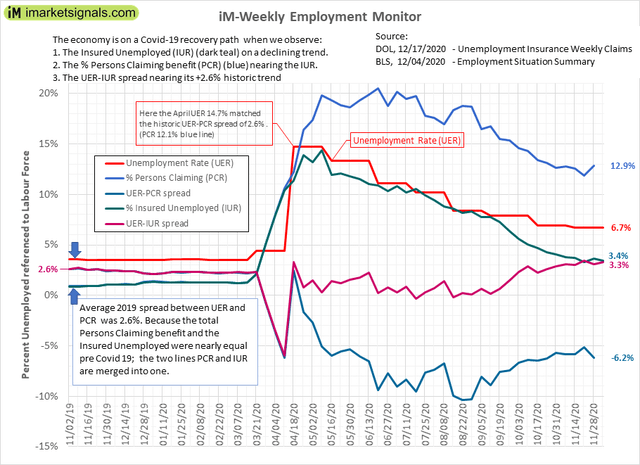Covid-19 Crisis: The iM-Weekly Unemployment Monitor: Update 12/17/2020
A truer picture of the employment situation is extracted from the Unemployment Insurance Weekly Claims (UIWC) report.
Persons receiving some form of unemployment benefit account for 12.9% of the labor force.
Monitoring of the weekly insured unemployed could provide early indication of recovery from the Covid-19 crisis.
The current UIWC and BLS report indicates that the economic recovery from the Covid-19 crisis seems to have stalled.
Today’s DOL Unemployment Insurance indicates a stagnant insured employment situation with initial claims near last weeks and the reported number of persons claiming benefits in all programs increased by 1.6 million from prior week
The non-seasonal adjusted initial claims totaled 935,138 in the week ending December 12, again over 900,000 and a small decrease of 21,335 from the previous week. This makes up 0.64% of the Covered Employment. The 50 year long term average (January 1971 to today) is 0.38% and the average of the last business cycle (July 2009 to March 2020) is 0.24%
The non-seasonal adjusted continuous insured unemployment totaled 5,492,701, a decrease of 312,357 from the preceding week, a decrease probably attributed to exhausting benefits.
Also, total number of people claiming benefits in all programs for the week ending November 28 was 20,646,779, an increase of 1,603,281 from the previous week.
These reported numbers, which are graphed below, indicate:
- A continued improvement in the return to work trend (continued decrease in the insured unemployed - green line) and the possible easing of the Covid-19 recession.
- That the lowest unemployment rate should be 12.9% (blue line), and if one added the historic 2.6% UCR-PCR spread then the actual unemployment rate should be 15.5%.
 In the current Covid-19 situation we believe that the only meaningful figures from DOL’s weekly report are:
In the current Covid-19 situation we believe that the only meaningful figures from DOL’s weekly report are:
- The non-seasonal adjusted Insured Unemployed.
- The total of all persons claiming unemployment benefits in all programs, which includes persons receiving Covid-19 relief who would normally not fall into the insured employed, e.g. self-employed tech workers.
In the figure above we graph the following:
- The monthly unemployment rate (UER) as published by the BLS, plotted 2 weeks earlier from the reporting date. (The May UER which is published beginning June is plotted from mid-May to mid-June.
- The insured unemployed rate (IUR) is the percentage of insured unemployed persons (not seasonally adjusted) of the labor force. (The number of insured unemployed is published every Thursday, looking back 2 weeks in the DOL’s weekly Unemployment Insurance Weekly Claims report. The labor force is published monthly by the BLS with the Employment Situation Summary.)
- The unemployed persons claiming rate (PCR) is the percentage of persons of the labor force claiming UI benefits in all programs, including the insured unemployed. (The total number of persons claiming benefit is published weekly looking three weeks back.)
- The spread UER-IUR, historically at 2.6% (2019 average)
- The spread UER-PCR, also historically at 2.6%, as the majority of persons claiming benefit were the insured unemployed.
A recovery would be indicated by the following:
- Significant and continues decline in the insured unemployment rate, together with a
- Significant decline of total persons claiming benefit, which implies
- The spread UER-PCR approaching its historic value of 2.6%.
Disclosure: I/we have no positions in any stocks mentioned, and no plans to initiate any positions within the next 72 hours.
I wrote this article myself, and it expresses my own opinions. I am not receiving compensation for it. I have no business relationship with any company whose stock is mentioned in this article.
Disclosure: I/we have no positions in any stocks mentioned, and no plans to initiate any positions within the next 72 hours. I wrote this article myself, and it expresses my own opinions. I am not receiving compensation for it. I have no business relationship with any company whose stock is mentioned in this article.
